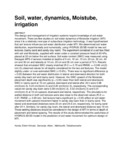| dc.description.abstract | The design and management of irrigation systems require knowledge of soil water movement. There are few studies on soil water dynamics of Moistube irrigation (MTI) since it is a relatively new type of subsurface irrigation technology. It was hypothesised that soil texture influences soil water distribution under MTI. We determined soil water distribution, experimentally and numerically, using HYDRUS 2D/3D model for two soil textures (loamy sand and sandy clay loam). The experiment consisted of a soil box filled with soil and Moistube, supplied with water under a constant pressure head of 60 kPa, placed at 20 cm below the soil surface. Soil water content (SWC) was measured using Decagon MPS-2 sensors installed at depths of 5 cm, 10 cm, 15 cm, 20 cm, 30 cm, 40 cm and 50 cm and laterally at 10 cm, 20 cm and 30 cm over a period of 72 h. Results showed that simulated SWC closely matched (R-2 >= 0.70 and RMSE <= 0.045 cm(3) cm(-3)) observed values for all depths considered for the two soil textures. The model slightly under- or over-estimated SWC (<15.6%). There was no significant difference (p > 0.05) between the soil water distribution in lateral and downward direction for both sandy clay loam soil and loamy sand. However, the SWC upward of the Moistube placement depth was significantly (p < 0.05) lower than both lateral and downward. SWC in loamy sand at 10 cm upward, downward and lateral after 24 h were 0.08 cm(3)cm(-3), 0.23 cm(3)cm(-3) and 0.20 cm(3)cm(-3), respectively. The corresponding values for sandy clay loam were 0.28 cm(3)cm(-3), 0.32 cm(3)cm(-3) and 0.31 cm(3)cm(-3) at 10 cm upward, downward and lateral, respectively. The simulations for wetted distance in both soil textures were also close to the observed values (R-2 >= 0.97, RMSE <= 3.99 cm). Soil texture had a significant (p < 0.05) effect on soil water movement with upward movement faster in sandy clay loam than in loamy sand. The lateral and downward distances were 23 cm and 24.6 cm, respectively, for loamy sand after 24 h. Similarly, for sandy clay loam, the lateral and downward distance was 19 cm. These wetting distances should be considered in the design of MTI in terms of depth of placement and lateral spacing. The results of this study demonstrated the usefulness of HYDRUS-2D/3D model in the prediction of soil water movement for optimum design of MTI. | en_US |

